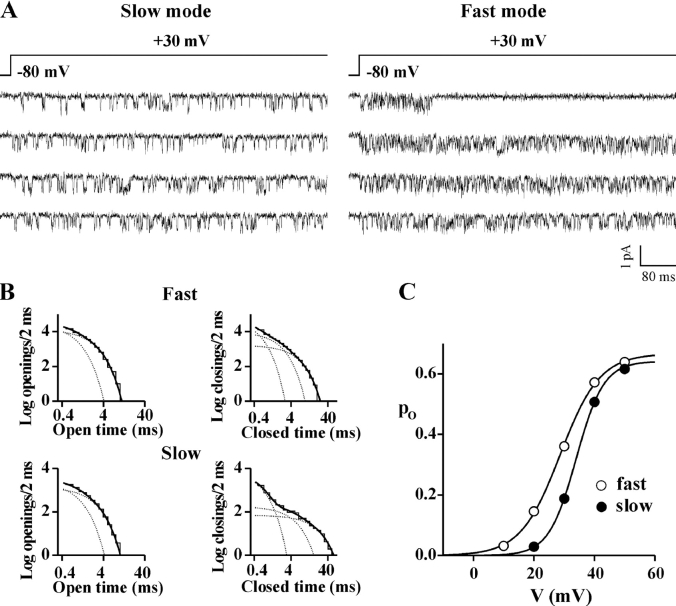Figure 1.
A single human CaV2.1 channel shows two different modes of gating: the fast and slow modes. Cell-attached single channel recordings with 90 mM Ba2+ as charge carrier on HEK293 cells stably coexpressing human CaV2.1α1 (α1A-2), β1b and α2bδ-1 subunits. Depolarizations were 720 ms long and were delivered every 4 s from a holding potential of −80 mV. Records were sampled and filtered at 5 and 1 kHz, respectively. (A) Consecutive traces in two different periods from a patch containing a single CaV2.1 channel. By visual inspection, the channel was in the mode of gating shown on the left (the slow gating mode) during the first 8 min of recording, and in the mode of gating shown on the right (the fast gating mode) during the remaining 40 min. Single channel current and conductance were identical in the two periods. (B) Log–log plots of the open and closed time distributions of the same single channel in the two periods in fast and slow gating mode. The dark solid line in each plot is the best-fitting sum of two or three exponential components for the open or closed times, respectively (each exponential component is shown as a dotted line); time constants of the open times: 0.54 and 1.42 ms (relative areas 40 and 60%) for the slow mode and 0.40 and 1.36 ms (relative areas 71 and 29%) for the fast mode; time constants of the closed times: 0.34, 3.17, and 13.4 ms (relative areas 64, 14, and 22%) for the slow mode, and 0.29, 1.17, and 3.54 ms (relative areas 43, 38, and 19%) for the fast mode. (C) Open probability, po, as a function of voltage for the same single channel gating in the fast (empty symbol) and slow (dark symbol) mode. Fit of the two activation curves with a Boltzmann equation gives V1/2 = 34 mV, k = 4.5 mV, and po max = 0.64 for the slow mode and V1/2 = 29 mV, k = 6.6 mV, and po max = 0.67 for the fast mode. The companion paper (Fellin et al., 2004) describes two additional modes of gating of CaV2.1 channels named b and nb modes; the single channel shown here was in the nb mode for the entire duration of the recording.

